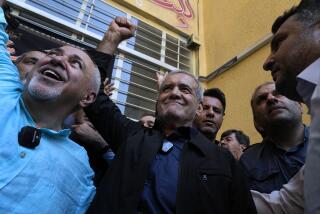U.S. Views of Iran Remain Off Target
- Share via
We are learning again that the United States can’t avoid dealing with Iran. Separating the Soviet Union from the warm waters of the Persian Gulf and the Indian Ocean, Iran is the key buffer between Soviet ambitions and Western interests. This fact produced the first serious U.S.-Soviet confrontation in 1946, when Moscow tried to install a left-wing autonomous government in Azerbaijan.
The West prevailed, thanks to American firmness and Iranian resistance to Soviet pressures. Indeed, during the last 40 years and even after the Islamic revolution, the West has succeeded in securing its principal interest in Iran: denying the Soviet Union a preponderant influence. Yet successive U.S. Administrations have seriously misunderstood Iran. This has often led to misguided U.S. policies, the effects of which sooner or later have come back to haunt the United States. During the early 1950s Americans misjudged the strength of nationalist feelings in Iran and the symbolic importance of oil nationalization. Thus, in thwarting a genuine nationalist movement in 1953, the United States earned the wrath of many Iranians and effectively denied broad national legitimacy to the Pahlavi regime that it helped restore to power.
U.S. failure to understand underlying social, economic and political dynamics in Iran has been compounded by long periods of simply ignoring it. This pattern was repeated during the 1960s and ‘70s, when the West viewed Iran through the eyes of the shah and the narrow-based elite around him. Thus most Westerners misread the true nature of the revolutionary wave that swept Iran in 1978-79.
With the benefit of hindsight, many Iran-watchers now argue that they foresaw the clerical victory in Iran. In fact, the Carter Administration had hoped to see the shah replaced by a moderate, liberal, nationalist regime similar to the one that Washington had blocked a quarter of a century earlier. Yet times had changed, and the United States was wise about Iran too late. What might have been achieved in 1953 was no longer possible in 1978.
Today’s debate on U.S.-Iranian contacts also betrays misunderstanding, by both sides, of Iranian realities. Opponents of the contacts view Iran as totally dominated by Islam, run by zealot clerics and posing a mortal threat to U.S. friends in the Middle East. Taken together, these conditions permit no compromise with the regime of the Ayatollah Ruhollah Khomeini.
This is a distorted view. Islam is extremely important in Iran, but so is nationalism. Iran’s war with Iraq, which largely follows the same Shia Muslim faith, is fueled by Iraq’s portrayal of the conflict as a historic defense of Arabism against the Persians.
The ideological rigidity of Iranian leaders and their lack of experience in international affairs also has been exaggerated. Many have proved capable of pragmatism, and have learned much about the demands of international life. Mired in its seven-year stalemate with Iraq, Iran is militarily incapable of overrunning its Arab neighbors or of effectively penetrating and destabilizing Arab societies.
Many advocates of U.S.-Iranian rapprochement also make a key mistake. They are motivated not by a desire to reach an accommodation with Iran’s current realities, but rather by hopes of generating dramatic change, including a change of regime. They underestimate the effects that eight years of revolutionary government and seven of war have had on a young, growing, frustrated and highly politicized population. Certainly Iran will not return to being the complacent country that it was for America during the days of the shah. And if sudden change were to come to Iran, it would likely produce more radicalism, whether secular or Islamic, and new opportunities for the Soviet Union.
No doubt it is difficult for many Americans to forgive, much less forget, the humiliation meted out by Khomeini during the hostage crisis of 1979-81. Television still brings into American living rooms images of militant unshaven Iranian youths shouting imprecations about “the Great Satan.” But this is only one picture of Iran, and by no means an adequate reflection of a complex society. Many Iranians are at least aware that their geopolitical predicament requires that some country, meaning the United States, must provide a balance to the Soviet Union.
The verbal and psychological struggle between Iran and the United States will continue. But, at heart, each needs the other. Indeed, the depth of feelings on both sides is partly testimony to this fact, and to mutual frustration that there appears to be no practical alternative.
The question of trading weapons and compromising on terrorism aside, Ronald Reagan has indicated to Iranians that the United States is prepared to come to terms with the revolution and play the classic role of balancing Soviet power without demanding a shah’s subservience. There is much for Iranians to learn in his approach. No less do Americans have to learn about Iran.
More to Read
Get the L.A. Times Politics newsletter
Deeply reported insights into legislation, politics and policy from Sacramento, Washington and beyond. In your inbox twice per week.
You may occasionally receive promotional content from the Los Angeles Times.









